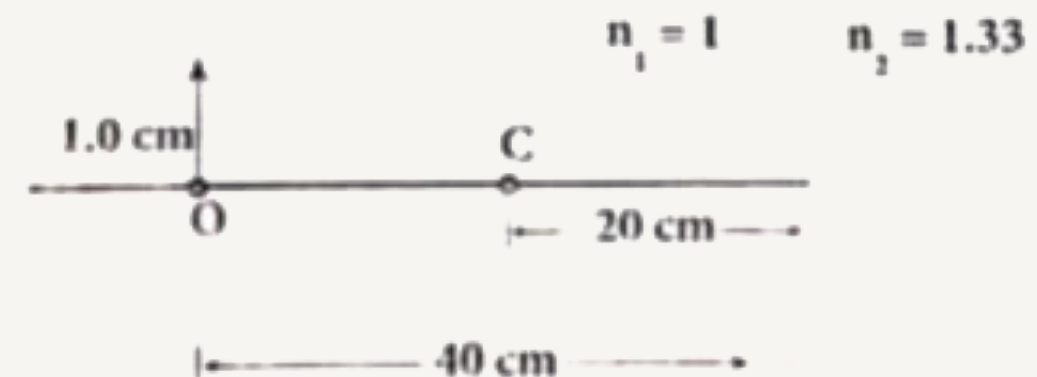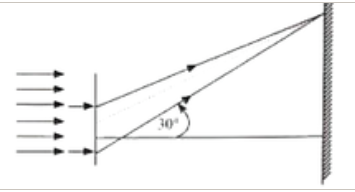Complete Solutions to IN - TEXT SOLVED EXAMPLES of chapter OPTICS of Class 12 book with complete answers and questions
| Class 12 | PHYSICS |
| Chapter | OPTICS |
| FULL MARKS | IN - TEXT SOLVED EXAMPLES |
| Number Of Questions | 45 |
| Academic Year | 2023-24 |
Prove that when a reflecting surface of light by an angle `theta`, the reflected light will be tited by an angle 20.
View SolutionA man having height 6 m, want to see full height in mirror. They observe image of 2 m height erect, then used mirror is
View SolutionAn object is placed at a distance of 20.0 cm from a concave mirror of focal length 15.0 cm.
(a) What distance from the mirror a screen should be placed to get a sharp image?
(b) What is the nature of the image?
View SolutionA thin rod of length f/3 is placed along the optical axis of a concave mirror of focal length f such that its image which is real and elongated just touches the rod. Calculate the magnification
View SolutionOne type of transparent glass has refractive index 1.5. What is the speed of light through thi glass?
View SolutionLight travels from air into glass slab of thickness 50 cm and refractive index 1.5.
(i) What is the speed of light in glass?
(ii) What is the time taken by the light to travel through the glass slab?
(iii) What is the optical path of the glass slab?
View SolutionLight travelling through tranparent oil enters in to glass of refractive index 1.5. If the refractive index of glass with repect to the oil is 1.25, what is the refractive index of the oil?
View SolutionA coin is at the bottom of a trough containing three immiscible liquids of refractive indies 1.3. 1.4 and 1.5. poured one above the other of height 30 cm, 16 cm, and 20 cm respectively. What is the apparent depth at which the coin appers to be when seen from air medium outside? In which medium the coin will be seen?
View SolutionWhat is the radius of the illumination when seen above from inside a swimming pool from a depth of 10 m on a sunny day? What is the total angle of view? [ Give refractive index of water is 4/3]
View SolutionA optical fiber is made up of a core material with refractive index 1.68 and a cladding material of refractive index 1.44. What is the acceptance angle of the fiber kept in air medium? What is the answer if there is no cladding?
View SolutionThe thickness of a glass slab is 0.25 m. It has a refractive index of 1.5 A ray of light is incident on the surface of the slab at an angle of `60^(@)`. Find the lateral displacement of the light when it emerges from the other side of the mirror.
View SolutionLocate the image of the point object O in the situtaion shown. The point C denotes the centre of curvature of the separating surface.
View SolutionFind the size of the image formed in the given figure.

View SolutionA biconves lens has radil of curvature 20 cm and 15 cm each. The refractive index of the material of the lens is 1.5. What is its focal length? Will the focal length change if the lens is fipped by the side?
View SolutionDetermine the focal length of the lens made up of a material of refractive index 1.52 as shown in the diagram. ( Points `C_(1)` and `C_(2)` are the centers of curvature of the first and second surface).
View SolutionIf the focal length is 150 cm for a glass lens, what is the power of the lens?
View SolutionWhat is the focal length of the combination if a lens of focal length - 70 c is brought in contact with a lens of focal length 150 cm? What is the power of the combination?
View SolutionAn object of 5 mm height is placed at a distance of 15 cm from a convex lens of focal 10 cm. A second lens of focal length 5 cm is placed 40 cm from the first lens and 55 cm from the object. Find
(a) the position of the final image.
(b) its nature and (c) its size.

View SolutionA monochromatic light is incident on as equallateral prism at an angle `30^(@)` and emerge at an angle of `75^(@)`. What is the angle of deviation produced by the prism?
View SolutionLight ray falls at normal incidence on the first face of an equilateral prism and emergres gracing the second face. What is the angle of deviation? What is the refractive indec of the material of the prism?
View SolutionThe angle of minimum deviation for a prism is `37^(@)`.If the angle of prism is `60^(@)` , find the refractive index of the material of the prism.
View SolutionFind the dispersive power of flint glass if the refractive indices of flint for red, green and violet light are 1.613, 1.620 and 1.632 respectively.
View SolutionThe wavelenght of light from sodium source in vacuum is 5893Å. What are its (a) wavelenght, (b) speed and ( c) frequency when this light travels in water which has a refractive index of 1.33.
View SolutionTwo light sources with amplitudes 5 units and 3 units respectively interfere with each other. Calculate the ratio of maximum and minimum intensities.
View SolutionTwo light sources of equal amplitudes interfere with each other. Calculate the ratio of maximum and minimum intensities.
View SolutionTwo light sources have intensity of light as `I_(0)`, What is the intensity at a point where the two light waves have a phase difference of `pi//3`?
View SolutionThe wavelenght of a light is 450 nm. How phase it will differ for a path of 3 mm?
View SolutionIn Young's double silt experiment, the two slits are 0.15 mm apart. The light source has a wavelenght of 450 nm. The screen is 2 m away from the slits.
(i) Find the distance of the second bright frings and also third dark frings from the central maximum.
(ii) Find the fringe width.
(iii) How will the frings pattern change if the screen is moved away from the silis?
(iv) what will happen to the fringe width if the whole setup is immersed in water of refractive index 4/3.
View SolutionTwo lights of wavelenght 560 nm and are used in Young's double slit experiment. Find the least distance from the centeral fringe where the bright fringe of the two wavelenght coindes. Give D = 1 m and d = 3 mm.
View SolutionFind the minimum thickness of a film of refractive index 1.25, which will storngly reffect the light of wavelenght 589 nm. Also find the minimum thikness of the film to be anti - reflecting.
View SolutionLight of wavelength 500 nm Pass through a slit of 0.2 mm wide. The diffraction pattern is formed on a screen 60 cm away. Determine the.
(i) angular spread of centeral maximum
(ii) the distance between the central maximum and the second minimum. `=
View SolutionA monochromatic light of wavelenght 5000Å passes through a single slit producing diffraction pattern for the central maximum as shown in the figure. Determine that width of the slit.

View SolutionCalculate the distance for which ray optics is good aproximation for an aperture of 5 mm and wavelenght 500 nm.
View SolutionA diffraction grating consisting of 4000 slits per centimeter is illuminated with a monochromatic light that produces the second order diffraction at an angle of `30 ^(@)`. What is the wavelenght of the light used?
View SolutionA monochromatic light of wavelenght of 500 nm strikes a grating and produces foruth order bright line at an angle `30^(@)`. Find the number of slits per centimeter.
View SolutionThe optical telescope in the Vainu Bappu observatory at Kavalur has an objective lens of diameter 2.3.m. What is its angular resolution if the wavelenght of light used is 589 nm?
View SolutionTwo polaroids are kept with their transmission axes inclined at `30^(@)`. Unpolarised light of intensity I falls on the first polaroid. Find out the intensity of light emerging from the second polaroid.
View SolutionTwo polaroids are kept corssed `("transmission axes at " 90^(@))` to each other.
(i) What will be the intensity of the light coming out from the seond polaroid when an unpolarised light of intensity I falls on the first polaroid?
(ii) What will be the intensity of light coming out from the second polaroid if a thrid polaroid is kept at `45^(@)` inclination to both of them.
View SolutionA light travels from air into water, the angle of refraction is `25^@` to the normal. Find the angle of incidence. Refractive index of water is 1.33 . `mu_a =1`
View SolutionWhat is the angle at which a glass plate of refractive index 1.65 is to be kept with respect to the horizontal surface so that an unpolarised light travelling horizontal after reflection from the glass place is found to be plane polarised?
View SolutionA man with a near point of 25 cm reads a book small print using a maagnifying glass, a convex lens of focal length 5 cm.
(a) What is the closest and the farthest distance at which he should keep the lens from the page so that he can read the book when viewing through the magnifying glass?
(b) what is the maximum and the minimum magnification (magnifying power) possible using the above simple microscope?
View SolutionA microscope has an object and eyepiece of focal lenghts 5 cm and 50 cm respectively with tube length 30 cm. Find the magnification of the microscope in the (i) near point and (ii) normal focusing.
View SolutionA small telescope has an objective lens of focal length 125 cm and an eyepiece of focal length 2 cm. What is the magnification of the telescope? What is the separation between the objective and eyepiece? Two stars separated by 1' will appear at what separation when viewed through the telescope?
View SolutionCalculate the power of lens of the spectacles necessary to rectify the defect of nearsightedeness fof a person who could see clearly only up to a distance of 1.8 m.
View SolutionA person has farsightedness with the minimum distance he could see early is 75 cm. Calculate the poer of the spectacts necessary to recify the defect.
View Solution
IN - TEXT SOLVED EXAMPLES questions and complete solutions for chapter OPTICS of FULL MARKS PHYSICS (TAMIL ENGLISH) of Class 12
All Exercises from FULL MARKS Class 12 PHYSICS OPTICS
- ADDITIONAL QUESITON - II ADDITIONAL PROBLEMS:
- ADDITIONAL QUESITON -( MULTIPLE CHOICE QUESTIONS )
- IN - TEXT SOLVED EXAMPLES
- TEXTUAL EVALUATION SOLVED V.NUMERICAL PROBLEMS
- TEXTUAL EVALUATION SOLVED IV.CONCEPTUAL QUESTION:
- TEXTUAL EVALUATION SOLVED LONG ANSWER QUESTION
- TEXTUAL EVALUATION SOLVED SHORT ANSWER QUESTION
- TEXTUAL EVALUATION SOLVED ( MULTIPLE CHOICE QUESTIONS : )